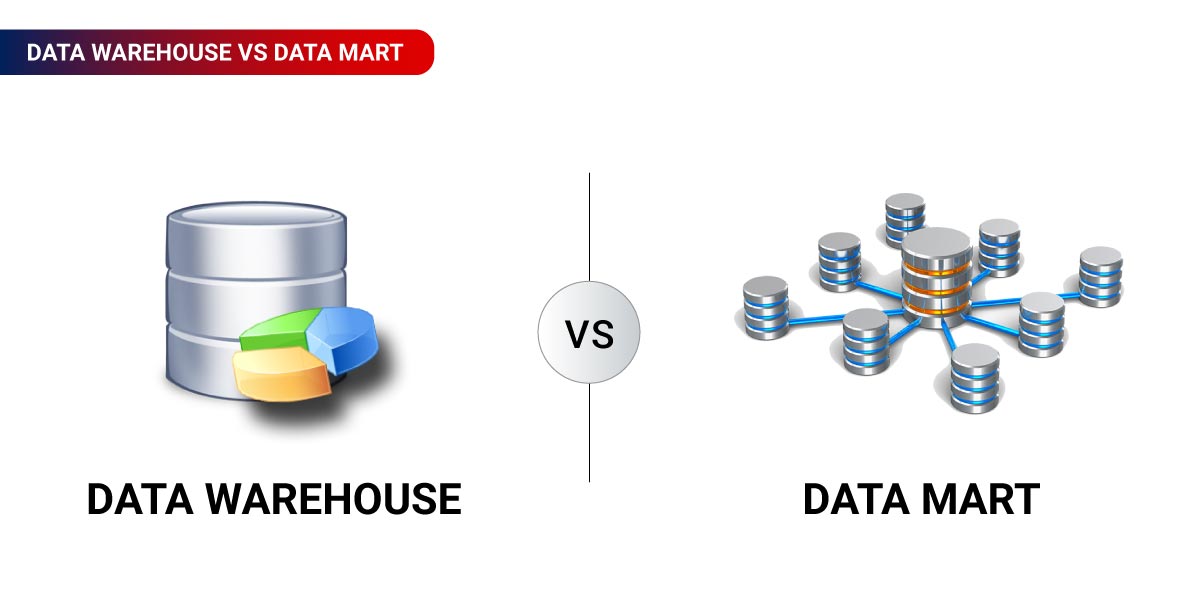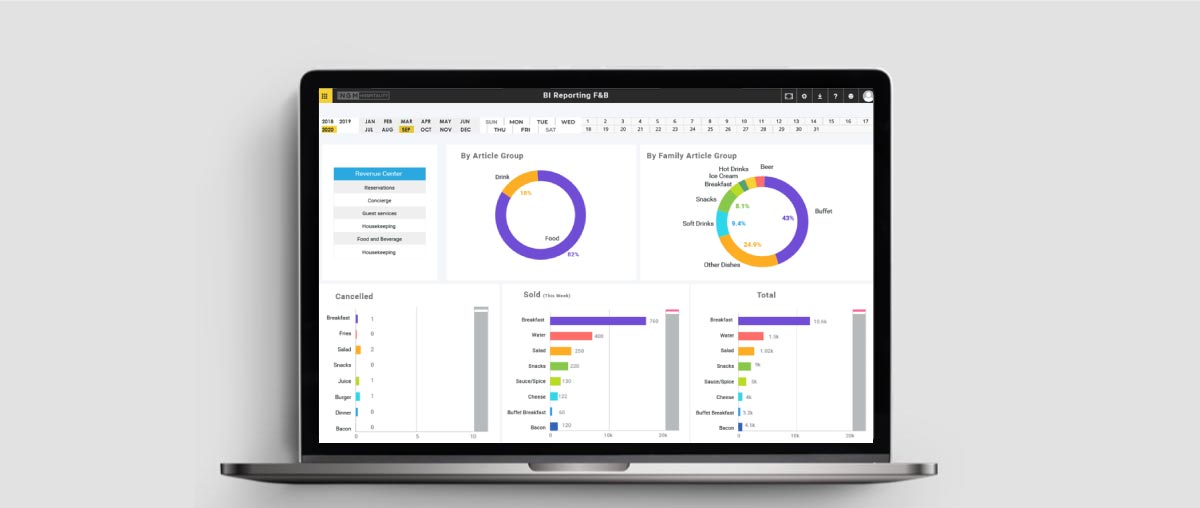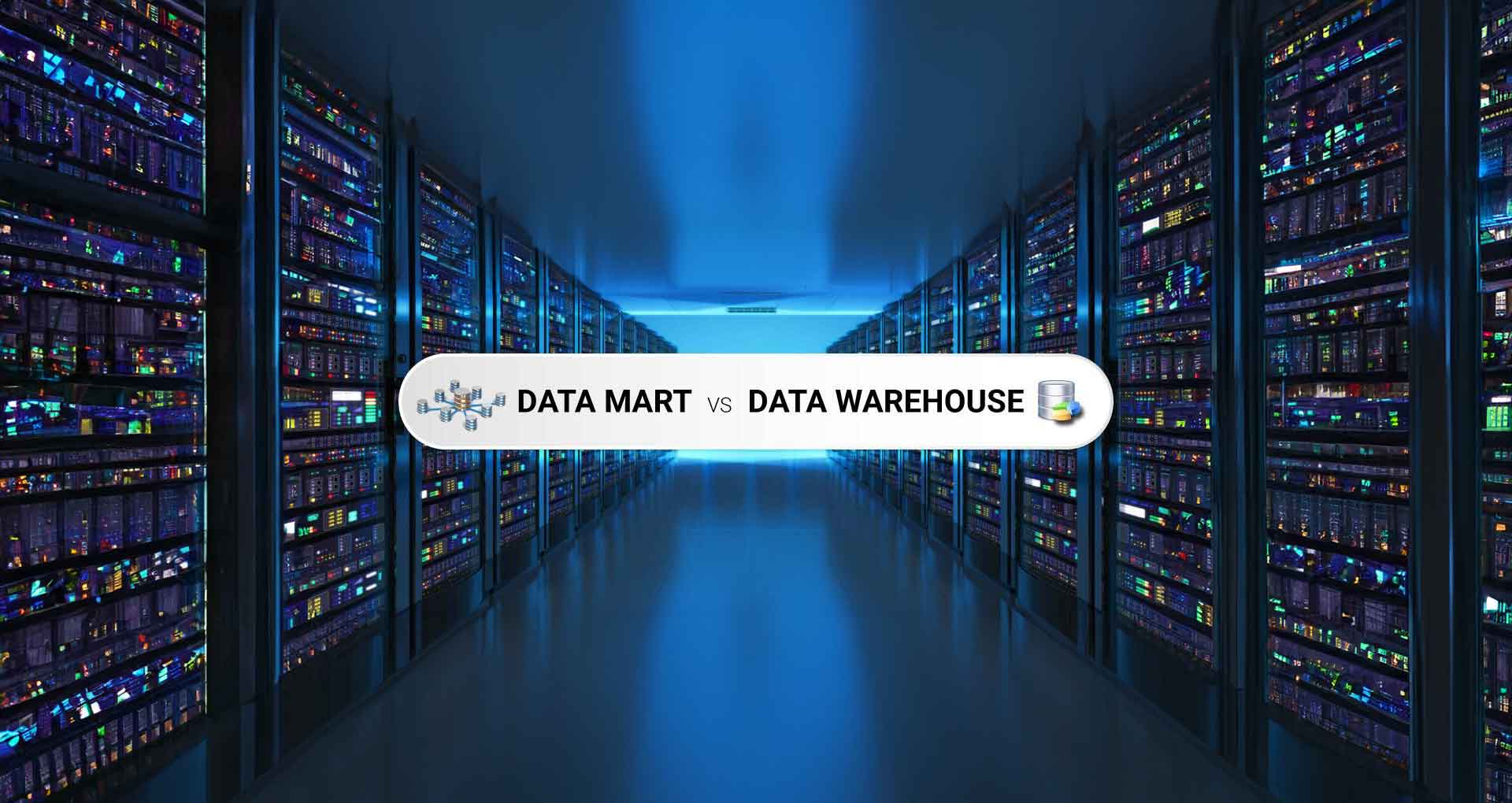In today’s data-driven world, organizations seek ways to manage & leverage their vast amounts of information. They rely on two fundamental approaches to extract valuable insights and achieve success: data marts and data warehouses. And while both play crucial roles in business intelligence (BI) & analytics, it is vital to understand the differences between data mart vs data warehouse. Further, it is essential for making informed decisions about data storage, retrieval & analysis strategies.
In this blog post, we will delve into specifics about data marts & data warehouses while exploring the use cases, benefits & how to address challenges. By clearly understanding these concepts, you’ll be better equipped to determine the most suitable solution for the organization’s data needs.
Before exploring the differences between data warehouse and data mart, let’s start with what it means.
- Data Warehouse (DWH) is a comprehensive and centralized repository consolidating large volumes of structured, semi-structured, and unstructured data from various sources within an organization. It enables efficient storage, organization, and analysis for enterprise-wide reporting and business intelligence purposes.
- Data Mart is a specialized and focused subset of a data warehouse that provides quick and tailored access to specific data for decision-making within a particular business unit.
Let us first briefly walk you through Ralph Kimball and Bill Inmon’s data warehouse concepts. Later we will explore the data warehouse vs data mart comparison explaining each parameter in detail.
Difference Between Inmon vs. Kimball Approach in Data Warehousing
For years there have been discussions about data warehouse approaches to design data warehouses for businesses. Two of the most predominant methods include the ones by data pioneers Bill Inmon and Ralph Kimball[1]. The debate continues around which approach is superior and more impactful in terms of effectiveness.
Inmon favors the data warehouse approach, centralizing data before loading it into data marts. In contrast, Kimball prioritizes the quick creation of mission-specific data marts within a dimensional data warehouse.
Differences Between Data Warehouse vs Data Mart
Data warehouses and data marts have different purposes and are built to be used differently. While a data warehouse serves as the comprehensive global database for a business, encompassing data from all aspects of the company, a data mart focuses on storing a limited amount of data specific to a particular business department or project. Let’s examine the differences between data warehouse and data mart while exploring their unique characteristics to manage and utilize data effectively.

Data Warehouse vs Data Mart Comparison
| Data Warehouse | Data Mart | |
| Objective | A centralized & single source of all data across the business organization. | A data source for a department or specific line of business. |
| Cost | High startup and ongoing support cost | Lower startup and ongoing support cost |
| Model | Top-down | Bottom-up |
| Setup Time | At least a year for on-premise warehouses; cloud data warehouses are much quicker to set up | 3-6 months |
| Size | More than 100GB to TB and beyond | Less than 100GB to TB |
| Normalization | mostly denormalized for quicker data querying and read performance | No preference between a normalized and denormalized structure |
| Implementation time | Months to years (on-premises), Days to weeks (cloud-based) | Weeks to months (on-premises), Days to weeks (cloud-based) |
| Data sources | Dozens or hundreds (Enterprise-wide apps and systems) | Typically, just a few (Department or Business line-specific apps and systems) |
| Data Handling | Its extensive data takes longer to process. | Its small amount of data takes less time to process. |
| Focus | Enterprise-wide repository of disparate data sources | A single subject or functional organization area |
| Nature | Data-oriented | Project-oriented |
| Scope | Broad scope, as it contains data from all departments and business lines. | Specific scope, as data mart has data of a particular department and business line. |
| Usage | Business-wide analysis | Department-specific analysis |
| Decision types | Strategic and tactical decision-making | Operational, tactical, and strategic decision-making |
| Ownership/Control | Enterprise level | Department level |
| Access | Tightly controlled access | Ease of access |
Data Mart vs Data Warehouse: Use Cases
Data Warehouses (DWH) and Data Marts have numerous applications across industries. Let’s take a look at the use cases of each of them individually.
Data Warehouse Use Cases Include,
- Historical Trend Analysis: Access to historical business data analysis lets decision-makers leverage reports, dashboards, and analytics tools to learn from past trends and make data-driven forecasts.
- BI Reporting & Dashboards: You could utilize its central repository to create interactive dashboards and generate reports. It provides quick access to critical information and key performance indicators (KPIs).
- Advanced Analytics: Helps conduct advanced analytics using data mining, machine learning, and predictive modeling techniques. You could uncover hidden patterns and optimize processes.
- Regulatory Compliance & Auditing: Ensures data integrity, accuracy, and consistency while facilitating regulatory compliance and audits.
- Customer Relationship Management: You can comprehensively view customer behavior, preferences, and interactions. A DWH enables personalized marketing, segmentation, and targeted sales strategies.
- Data Mining and Machine Learning: Offers a robust foundation for data mining & machine learning initiatives. And by consolidating & preprocessing data, DWH simplifies extracting relevant features and training machine learning models. Organizations of any size can leverage data warehouses to build predictive models, perform customer segmentation, fraud detection, and other advanced analytics.
Do give this blog a read if you wish to explore the DWH Industry Use Cases
Data Mart Use Cases Include,
- Sales and Marketing Analytics: Provides insights into customer behavior, campaign effectiveness, sales performance, and market trends. It enables customer segmentation analysis, campaign outcome monitoring, key performance indicators (KPIs), and optimized marketing strategies.
- Financial Analytics: Allows organizations to analyze financial data, including revenue, expenses, profitability, and financial ratios. It most importantly facilitates financial reporting, budgeting, forecasting, and variance analysis. It enables financial analysts to gain insights into cost structures, profitability by product or service, cash flow analysis & financial risk assessment.
- Human Resources Analytics: Provide insights into employee data, workforce trends, performance metrics, and talent management. HR professionals can analyze employee turnover, recruitment effectiveness, training and development programs, performance reviews, and workforce demographics. And finally, the said information can be used for workforce planning, talent acquisition & improving employee satisfaction.
- Supply Chain Analytics: Supports organizations to monitor & optimize their supply chain processes. It offers visibility into inventory levels, demand patterns, supplier performance, order fulfillment, and logistics. Finally, it enables supply chain managers to identify bottlenecks, optimize inventory levels, and improve order fulfillment efficiency while enhancing supply chain performance.
- Customer Analytics: Allows organizations to gain deep insights into customer behavior, preferences, and satisfaction. It helps consolidate customer data across varied touchpoints, such as sales, marketing, and customer service. And, eventually by analyzing this data, businesses can identify cross-selling and upselling opportunities, personalize customer experiences, and improve customer retention to enhance customer service.
- Risk and Compliance Analytics: Helps analyze risk and compliance-related data. It supports organizations in assessing and mitigating risks, monitoring compliance with regulatory requirements, and detecting potential fraud or anomalies. Further, it enables risk managers & compliance officers to track key risk indicators and conduct risk assessments while ensuring adherence to internal policies & external regulations.
Benefits of Data Warehouse and Data Mart
Businesses today are constantly looking for better ways to turn data into insights, which is where a data warehouse and data mart help centralize disparate content sources. Thus, by serving different purposes, they offer organizations unique benefits.
Benefits of Data Warehouse
- Interoperability Between On-premises & Cloud Apps: A DWH helps you seamlessly integrate on-premises and cloud-based infrastructure to improve data accuracy and efficiency.
- Centralized Data Repository: It enables storing data from various sources within an organization. And this consolidation eliminates data silos while allowing a single source of truth, ensuring data consistency and accuracy.
- Enhanced Data Accessibility: As a centralized source for all the data needs throughout the organization, the data warehouse consolidates the information which teams can use for reporting, analytics, insights, and decision-making.
- Improved Data Quality & Consistency: Data warehouse contains data from multiple disparate sources across the organization that is structured and cleansed by way of using a standard set of semantics. This results in accurate data with high consistency.
- Historical Data Analysis: Data warehouses often contain large amounts of historical data analysis, which helps organizations analyze different trends and patterns to make future predictions.
- Support for Complex Analytics: As a single point of access for all data across the organization, a data warehouse enables organizations to create reports, access multi-dimensional analysis, and get integrated insights.
- Support & Business Intelligence: Data warehouse makes data and insights easier to access using the ETL principle, thus allowing decision-makers in an organization to increase their decision-making quality.
To learn more about the benefits of cloud data warehouse around scalability, cost, and performance, check out this informative piece of content.
Benefits of Data Mart
- Improved Query Performance: Due to its focused nature and smaller size, a Data Mart enables faster query processing, resulting in improved performance.
- Ensured Data Integrity: A Data Mart is designed to ensure data consistency and accuracy, minimizing errors caused by redundant data and promoting trustworthy and reliable data usage.
- Cost-Effectiveness: They offer cost savings by storing specific subsets of data, reducing data storage costs. Additionally, their design and maintenance require less effort than the entire data warehouse, making them a cost-effective solution.
- Enhanced Data Accessibility: You can get quick and convenient access to specific subsets of data relevant to a particular business unit or function, eliminating the need to search the entire data warehouse.
- Increased Flexibility: Data Marts are easy to create, modify, and maintain to adapt to changing business needs, offering flexibility and agility in addressing evolving requirements.
Common Challenges in Data Mart and Data Warehouse
Both data marts and data warehouses come with their share of challenges for development and businesses.
Challenges in Managing Data Marts
- Limitations in Scalability and Integration: Data marts serve as data references for specific departments or business lines; thus, they may create isolated data repositories that are not a part of the data warehouse. This makes it difficult for your business data to integrate with other systems and offer a single version of the truth. With the creation of data silos, the scalability of your data also gets impacted adversely.
- Performance & Quality Issues: If your data mart is not correctly designed or appropriately optimized, it can get overloaded with queries. It can lower the data quality and decrease your data mart’s performance.
- Cost Considerations & Complexity: When your data mart development process doesn’t include sufficient planning and coordination, it can lead to data duplication, redundancy, and complexity. It increases your costs in redesigning the data architecture to fix the data mart’s functioning.
- Resource & Maintenance Requirements: Require proper monitoring, control, and timely support. Any potential lag can lead to using higher resources and efforts.
Challenges in Managing Data Warehouses
- Handling Large Data Volumes: Data warehouses manage terabytes & petabytes of data. And as data storage volume increases, it ensures excellent loading, and efficient storage to meet hyper-efficiency demand becomes challenging. Thus, ensuring that your database engines perform optimally is critical in maintaining the health of your data warehouse.
- Ensuring Data Quality and Governance: A DWH manages high volumes of both structured and unstructured data from multiple sources. You must therefore establish robust governance practices so your data warehouse can maintain data integrity to ensure your business data is accurate and reliable.
- Adapting to the Cloud Era: With increasing multi-cloud and hybrid environments, your data and IT infrastructure must integrate seamlessly within the data warehousing environment. Further, your DWH should facilitate accurate data analysis across disparate systems, which requires your personnel to have advanced skillsets and expertise.
- Empowering AI Capabilities: Enterprises today look to embrace AI and predictive analytics to transform their business operations and stay relevant in the highly competitive landscape. So, an increasing number of data warehousing solutions integrate Artificial Intelligence capabilities. However, it requires subject-matter experts and AI developers, thus, increasing your data warehouse development cost.
When to Use Data Warehouses and Data Marts?
Businesses consider many factors to determine when to utilize data mart vs warehouse based on their specific needs and objectives. Here are some elements to consider:
- Data Types: Data warehouses are well suited for organizations with massive amounts of data from specific sources. It is ideal for storing relational data, for example, patient healthcare data by healthcare organizations or customer and business process data by a banking organization. Since data warehouse stores structured data from disparate sources, it is better for analytical purposes and business reporting. In contrast, data marts are suitable for specific business needs of departments or business lines. For example, the HR department may create a data mart to maintain payroll, employee position, and employment history records. In contrast, the marketing department may make a data mart for social media advertising campaigns and customer records.
- Performance: Data marts offer better query performance as they handle smaller data subsets than data warehouses.
- Cost: Implementing independent data marts is more cost-effective than a data warehouse architecture.
- Data Volume: Data warehouses handle large data volumes in the terabytes range, whereas data marts typically handle data in the hundreds of gigabytes.
- Decision-making: Data warehouses support enterprise-level decision-making, while data marts enable focused data analytics at the department level, facilitating faster and more informed decision-making.
Partner with Rishabh Software for Data Warehouse and Data Mart Development
As an experienced company providing data warehouse consulting & development services, we can help you build comprehensive DWH solutions, including enterprise data warehouse (EDW), Operational Data Store (ODS), and Data Mart as per your business need. Our team can help you decide between data mart vs data warehouse, as we cover all four phases – from strategy & design to development & support.
Success Story: Cloud-Based Data Warehouse System

We built a Cloud Data Warehouse (DWH) Solution for a US-based F&B & Resort management giant to effectively manage the business data from 20+ data sources. Our solution served as the single version of the truth to help stakeholders get valuable insights into their requirements.
Our skilled and experienced team merged & collaborated data from multiple internal & third-party apps and built an operational data store, ETL, DWH, and Business Intelligence and deployed it on the Microsoft Azure Cloud.
Key Takeaways:
- 50% high workflow efficiency
- 40% lower data quality issues
- 99% accuracy in business understanding
Learn more about the features of our data warehouse solution for the hospitality business.
Wrapping it Up!
In the past, data warehouse setup was costly and time-consuming that lasted even months. Further, it needed expensive hardware servers for high-performance analytics. Then departments sought data insights; data marts were a cost-effective alternative during that period. But currently, data warehouses are crucial in facilitating important business decisions in the modern business setup. They serve as repositories for current and past data collected from various sources while consolidating them into a unified & reliable source of information that organizations rely upon with data-driven approaches.
And on the other hand, data marts help conduct tactical analyses tailored to specific departments. They offer user-friendly interfaces, streamlined design processes, and implementation. As a result, they are well suited for individual departments that are seeking specialized analytical capabilities.
Frequently Asked Questions
Q: What fundamental distinction exists between a data mart vs. a warehouse?
A: The core enterprise data warehouse vs. data mart difference is that a data warehouse serves as a centralized repository for comprehensive organizational data. In contrast, a data mart focuses on a specific subject area or business unit, providing targeted access to relevant subsets of data.
Q: What is an independent data mart, and who can use an independent data mart?
A: An Independent data mart is a separate and self-contained data mart created and managed independently from a centralized data warehouse. It suits organizations of any size or industry, particularly those with decentralized data management structures. Independent data marts empower specific departments or business units to have autonomous control over their data, catering to their unique requirements and enabling customized data access and analysis without relying on a centralized data warehouse. It is also helpful for organizations with short-term business objectives requiring focus on specific data sets.
Q: What is the purpose of the staging area for a data warehouse?
A: The staging area in a data warehouse provides a temporary location for copying data from source systems. It is necessary to accommodate timing differences in data availability and integration into the data warehouse. Due to varying business cycles, resource limitations, and geographical factors, extracting all data simultaneously is not feasible. For example, extracting sales data daily could be valid but not financial data, as it requires a monthly reconciliation process. The staging area allows data processing and integration based on specific timing requirements. Not all businesses need a staging area, as it may be feasible for them to use ETL (Extract, Transform, Load) to copy the data directly from data sources to the data warehouse.
Q: What are the basic steps in data mart implementation?
A: Steps to Implementing a data mart include the following
- Gathering requirements from business units.
- Designing the data mart strategy and aligning it with business goals.
- Constructing the data mart architecture and choosing the appropriate database.
- Populating the data mart with data from the data warehouse or other sources.
- Setting up queries and reports for user access.
- Managing and monitoring data mart performance, usage, and security.
Footnotes:











 30 Min
30 Min


